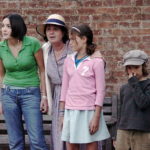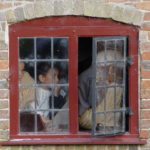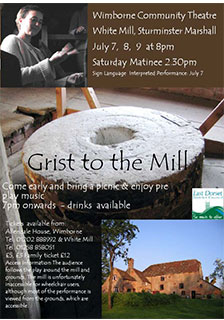Grist to the Mill • White Mill, Shapwick (2005)

 Make of our game
Make of our game
Just what you will
But let these three
Go through the mill.
When they’ve seen the daily grind
I wonder what else they will find?
The grain goes up
The flour comes down
And so the world goes round and round!

About the production
A play set in and around White Mill, revealing local folk stories and facts, including the story of the Knowlton Bell and the Shapwick Monster, and H S Joyce’s account of his life at White Mill in the 19th Century.
Photos
Video
The complete play in performance at White Mill, Sturminster Marshall.
Research
THE MILL AND THE BRIDGE
White Mill is now a peaceful spot off the beaten track and a pleasant place for a day out.
The mill wheel no longer turns and the mill race is dry. In its day it would have been very different. The narrow road was a main thoroughfare carrying traffic along the side of the river from Blandford to Wimborne and the bridge was seen as a feat of engineering. The Mill was a vital centre with a whole community relying on it for its daily needs.
- Imagine the Mill working – the sights, sounds and smells and the bustle of people coming and going across the bridge and along the river, all converging on the mill.
STORIES
Bashing the Bridge
Mr Folks’ plaque on the bridge warns that the punishment for damaging the bridge was transportation to Australia.
- Imagine a child of today – what is transportation? It sounds magical and Australia seems an agreeable place. He picks up a fallen branch and bashes away – he wants to be transported.
The Bell Story
There are many versions of the tale of Knowlton Church bells, stolen by the men of Sturminster Marshall. Crossing the bridge at White Mill with the bells in a hand cart, they realised they were being pursued. To avoid being caught with the incriminating evidence they decided to ditch their load off the bridge. The men of Knowlton or Sturminster Marshall and even those from Shapwick made many attempts to pull them out but they are said to be still there in White Mill Hole, a deep pool to the right of the bridge on the Sturminster Marshall side.
- Imagine the stories that grew up when the bells couldn’t be raised – some said it was divine intervention, some that the bells were cursed by an old crone, some heard the bells at time of danger ringing a warning peal. Even today, they say, if you listen very carefully on a warm summer’s afternoon or in the still of a moonlit night you can still hear them tolling to the flow of the river.
The Crab Story
A fisherman from Poole was taking his catch to sell in Blandford when, as he was passing through Shapwick, a large crab fell out of his cart. A simple young man who had never been out of the village told others of the strange creature and soon word spread that there was a monster in the village. It was imprisoned in a barn until, much to the villagers’ relief, a more widely travelled visitor from Sturminster Marshall offered to dispose of the “monster”. He took it home and ate it but the Crab has lived on in the folk lore of the village and can be seen in place names and emblems in the area.
- Imagine the uproar and panic in the village when the crab is found.
The Flood Story
There were many threats to the mill, particularly fire and flood. As the huge wooden cogs engaged to turn the mill stones, the miller was always vigilant in case the heat generated caused a fire.
The river rose many times over the centuries and flooded the mill. H S Joyce recalls one occasion when the cook at the time was woken by the crying of the cats which had the run of the mill floor at night to hunt for rodents. She found them on a table floating on water a foot deep. Wading through the icy water she rescued them one by one as the table passed the door.
- Imagine the audience participating in a human chain to bring buckets of water to fight a fire – sound and light used to interpret the fire.
- Imagine the audience watching the flood story from different points outside the mill, infiltrated and guided into position by the spirits of the river and other characters.
CHARACTERS
The Miller – all the millers over the centuries could be encompassed in one character. The Joyce family ran the mill from about 1550 to the early 1900s. One miller was a renowned singer in the community.
The Water Cress Man – a regular visitor known to the miller. He was honest and hardworking in spite of his untidy tramplike appearance – he could encompass the Water Rat, the Bogey Man and the Troll.
The Old Crone – mentioned in the Bell Story. A wise woman who could be the miller’s elderly toothless aunt Anne Hater who knew many stories and songs.
The Spirits Of The River – these could include Water Nymphs, Egrets, Swans, Moorhens, Pike and the Blandford Fly. The river is the reason for the existence of the mill and the bridge; it gives the mill its power; it has changes of mood which determine the pulse of life in the mill; it is the giver and taker of life.
H S Joyce – Writer and illustrator, son of the last miller, born and spent his early childhood at the mill. Author of A Country Childhood.
The Simple Village Boy – the boy from Shapwick featured in the Crab Story.




























